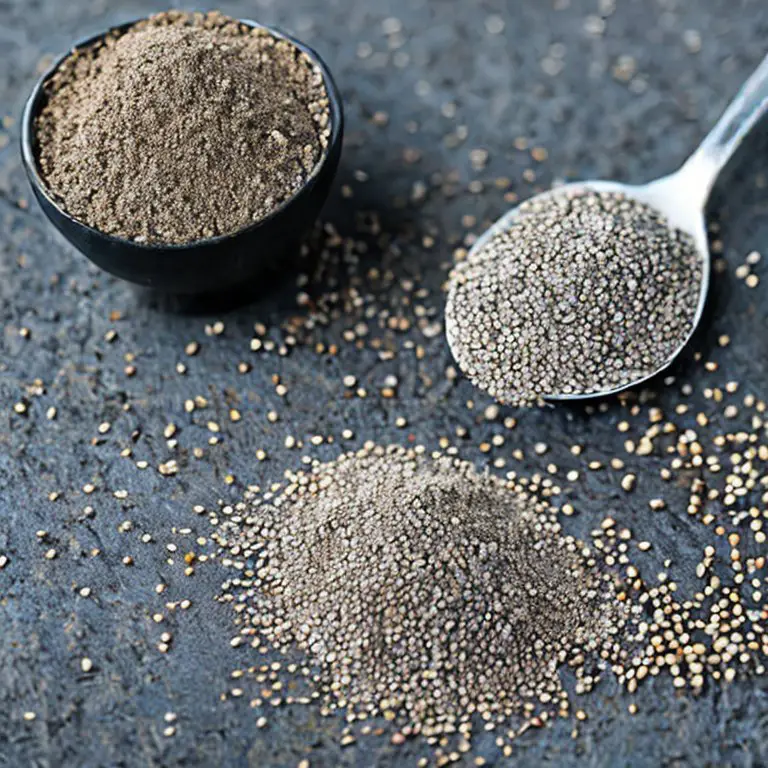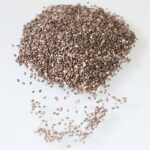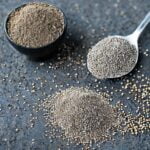
Chia seeds are a healthy type of seed that are often used as an ingredient in a variety of dishes and drinks, and are considered a healthy alternative to other types of seeds and grains.
One question that often arises when using chia seeds is whether or not they need to be ground before eating them. In this post, we will explore the answer to this question and provide information on the benefits and drawbacks of grinding chia seeds.
- Do You Need to Grind Chia Seeds?
- Ground Chia Seeds Benefits
- How to Grind Chia Seeds
- Ways to Eat Chia Seeds
- Are There Dangers of Chia Seeds?
Do You Need to Grind Chia Seeds?
The short answer is that chia seeds do not need to be ground in order to be consumed. They can be eaten whole, and are often added to foods and drinks as a source of nutrients and fiber. (See: Can You Eat Chia Seeds Raw?)
That being said, grinding chia seeds can have some benefits. For one, it can make them easier to digest. When chia seeds are ground, they are broken down into smaller pieces, which can be more easily digested by the body. This is especially useful for people who have difficulty digesting whole seeds or grains.
Grinding chia seeds may also increase their nutrient absorption. When chia seeds are ground, the surface area of the seed is increased, which allows for more contact with digestive enzymes. This can help the body to more efficiently absorb the nutrients contained within the seed.
Two studies (1,2) did find that ground chia seeds were better at increasing ALA and EPA levels, than eating the chia seeds in the whole form or soaked form.
A more recent study found that chia seeds that were ground, increased the uptake of antioxidants and nutrients compared to whole chia seeds or sprouted (soaked) chia seeds.
You will still get the fiber from chia seeds that are not ground, but if you want maximum uptake of nutrients, then consider grinding your chia seeds. (Learn more about the science at Ground Chia Seeds vs Whole)
The only drawback to grinding chia seeds, however, is that it will take a little more time to prepare them than if you eat them whole. Also, you will need to have the right type of grinder or way of grinding them, as we will look at later on.
So, do chia seeds need to be ground? The answer is no, they do not need to be ground in order to be consumed. However, grinding chia seeds can have some benefits, including making them easier to digest and increasing their nutrient absorption.
If you do choose to grind chia seeds, it is a simple process we’ll look at in a little bit that can be done using a coffee grinder or blender. Just be sure to store the ground seeds in an airtight container in the refrigerator to prevent them from losing any nutritional value.
Ground Chia Seeds Benefits
Ground chia seeds are a great source of nutrients and offer a number of benefits when consumed as part of a healthy diet. We saw earlier that ground chia seeds can provide greater benefits than whole chia seeds by increasing their digestibility. Here are some of those key benefits the ground chia seeds provide:
- High in Fiber: Ground chia seeds are an excellent source of fiber, which can help to promote regular bowel movements, lower cholesterol levels, and help with weight management. (See How to Use Chia Seeds for Weight Loss)
- Rich in Omega-3 Fatty Acids: Ground chia seeds are rich in omega-3 fatty acids, which are essential for heart health and can help to reduce inflammation in the body.
- Good Source of Protein: Ground chia seeds are a good source of plant-based protein, which is essential for the growth and repair of tissues in the body.
- Rich in Antioxidants: Ground chia seeds contain high levels of antioxidants, which can help to protect the body against damage caused by free radicals.
- Can help with diabetes management: The high fiber content in chia seeds can help to slow down the digestion process, leading to a more stable blood sugar level, which can be beneficial for people with diabetes or those who are looking to manage their weight.
- Promote bone health: Ground chia seeds contain an adequate amount of calcium, magnesium, and phosphorus, these minerals play an important role in bone health.
- Gluten-free: Ground chia seeds are gluten-free, which makes them a great alternative for people who are gluten intolerant or following a gluten-free diet.
(Learn more at Ground Chia Seeds Benefits – What Are They?)
How to Grind Chia Seeds
There are a few different ways to grind chia seeds. One option is to use a coffee grinder or spice grinder. Simply place the chia seeds in the grinder and pulse until they reach the desired consistency.
Another option is to use a blender. However, note that depending on the type of blender, this might not be the best option.
Spice grinders and coffee grinders and designed to grind small objects, unlike most blenders. So a lot of blenders will leave too much of the chia seeds not ground up. But to use a blender to grind them, simply add the chia seeds to the blender and pulse until they are ground to the desired consistency.
(Learn more at How to Grind Chia Seeds – Numerous Easy Methods)
Ways to Eat Chia Seeds
Chia seeds can either be eaten in their whole form, ground up, or soaked before consuming them.
You can then add them to a variety of dishes, your oatmeal, smoothies, or more. You can even make chia water to drink throughout the day. You can find more helpful uses at How to Eat Chia Seeds.
How to Use Ground Chia Seeds
Ground chia seeds are a versatile ingredient that can be used in a variety of dishes and drinks. Some of the ways to use ground chia seeds include:
- Baking: Ground chia seeds can be used as a thickener and binding agent in baking recipes. They can be added to flour mixtures to make bread, muffins, and pancakes, or used as a substitute for eggs in vegan baking.
- Smoothies: Ground chia seeds can be added to smoothies to increase their nutritional value. They can be blended with fruits, vegetables, and liquid to create a thick, creamy smoothie.
- Oatmeal: Ground chia seeds can be added to oatmeal to increase its fiber content. They can be stirred in before cooking or sprinkled on top after cooking. This is our favorite way to use them.
- Yogurt: Ground chia seeds can be added to yogurt for a crunchy texture and added nutrients.
- Salads: Ground chia seeds can be used as a topping for salads for a nutty flavor and added fiber.
- Salad dressing: Ground chia seeds can be added to salad dressings to thicken them.
- Sauces: Ground chia seeds can be added to sauces to thicken them and add nutritional value.
When using ground chia seeds, it is important to note that they absorb liquid quickly, so they are best added to dishes or drinks right before serving. It is also recommended to start with a small amount of ground chia seeds and increase this amount over time.
(Learn more ways at How to Use Ground Chia Seeds)
Should You Grind Chia Seeds for Smoothies?
As mentioned previously, grinding chia seeds help the body to absorb more of their nutrients. Because of this, it would be better to grind chia seeds before putting them into smoothies.
But even if you chose not to grind them, it will still be beneficial to add whole chia seeds to your smoothies. They may even have some time to soak in the liquid, depending on how long it sits before it’s consumed.
If you are going to allow the chia seeds to sit for some time after they are mixed into the smoothie, then you may want to just skip the grinding process and save yourself some time. (This is because soaked chia seeds are also useful in absorbing more of the chia seed nutrients).
Can You Eat Chia Seeds without Soaking?
Another method to prepare chia seeds before eating them is to soak them. It is also possible to eat chia seeds without soaking them first as well. Chia seeds can be eaten dry, whether they are whole or ground, and are often added to foods and drinks as a source of nutrients and fiber.
That being said, soaking chia seeds before consuming them can have some benefits just as with grinding them. When chia seeds are soaked in liquid, they absorb the liquid and form a gel-like substance. This can also make them easier to digest and may also increase their nutrient absorption. (See Chia Seeds Soaked in Water Overnight Benefits)
To soak chia seeds, simply add them to a liquid of your choice (such as water, milk, or juice) and let them sit for about 15-20 minutes. (See How Long to Soak Chia Seeds) The seeds will absorb the liquid and become soft and gelatinous. You can then add the soaked chia seeds to a variety of dishes or drinks, or eat them on their own.
So, can you eat chia seeds without soaking them? Yes, you can. However, soaking chia seeds before consuming them can have some benefits in terms of digestion and nutrient absorption, and is an alternative to grinding chia seeds. (Learn more at Can You Eat Chia Seeds Without Soaking?)
Are There Dangers of Chia Seeds?
Chia seeds are generally considered safe to consume and are not known to have any serious side effects. However, as with any food, it is possible to have an allergic reaction to chia seeds. Symptoms of a chia seed allergy may include hives, difficulty breathing, and swelling of the face, lips, tongue, or throat. If you experience any of these symptoms after consuming chia seeds, seek medical attention immediately.
In addition, it is important to note that chia seeds are high in fiber. As such, consuming large amounts of chia seeds may cause digestive symptoms such as bloating, gas, and constipation. (See What To Do if You Eat Dry Chia Seeds? to learn more about these)
To prevent these symptoms, it is recommended to start with a small serving of chia seeds and gradually increase your intake as your body becomes accustomed to them. (Learn more at How Much Chia Seeds Should You Eat a Day?)
It is also worth noting that chia seeds are high in calories and fat, so it is important to consume them in moderation as part of a balanced diet.
Overall, chia seeds are a healthy and nutritious food that can be enjoyed as part of a balanced diet. However, as with any food, it is important to pay attention to your body and seek medical attention if you experience any unusual symptoms after consuming chia seeds. (Learn more at Dangers of Chia Seeds)
Lance has been passionate about the plant-based diet and we have been following a whole food plant-based diet for over 5 years. We focus on health, natural healing, weight management, animal rights, and the health of the planet and environment by focusing on whole plant-based foods and sustainable practices.
Learn more at the About Me page and follow on social media at the links below.





